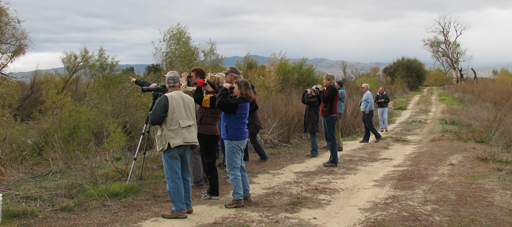


The San Joaquin River National Wildlife Refuge is a protected area of along the San Joaquin River in the northern San Joaquin Valley, California. It is within San Joaquin County and Stanislaus County.
At the San Joaquin River NWR visitors can explore the Pelican Nature Trail that is 4 miles long, and the Beckwith wildlife viewing area off Beckwith Road.
The Pelican Nature Trail meanders through seasonal wetlands, restored riparian woodlands, and stands of old-growth valley oak trees. The trailhead includes an educational seven-acre native vegetation free-roam exploration area.
The Beckwith observation platform is open seasonally mid-October through mid-March, and overlooks Refuge agricultural fields and grasslands that provide forage for thousands upon thousands of Aleutian cackling geese and lesser Sandhill cranes.
Getting There
The refuge, which is open from a half-hour before sunrise to a half-hour after sunset, can be reached from either Interstate 5 or Highway 99.
Coming from the west take Interstate 5 to the Highway 132 exit near Vernalis. Continue east on Highway 132 for about seven miles, then turn right on River Road. Coming from the east, take Highway 99 to Highway 132, travel west for about 12 miles, then turn left on River Road.
Continue along River Road for about three miles, then make a left on Dairy Road. A brown National Wildlife Refuge sign on the right marks the turn. The refuge is about 1.5 miles down Dairy Road on the right. It’s a 1 hour 20 minute-drive from San Francisco, and a 25-minute drive from Modesto. If you’re using GPS, the address of the refuge is 2714 Dairy Road, Vernalis, CA.
Accessible parking is located in front of the accessible vault toilets. From there an accessible path leads straight ahead to the main trail, and right over to the picnic area. Don’t forget to pick up a map at the entrance kiosk, as it’s easy to get turned around in the refuge.
Wander Through the Wetlands
There are several hiking options at the refuge, but the most popular one is the Wetlands Loop. From the parking lot follow the hard-packed dirt trail covered in decomposed granite to another kiosk, then cross the access road to continue on the trail. The .6 mile trail is mostly level, and covered with stabilizing gravel. The gravel is not deep, and it’s generally passable for wheelchair-users and slow walkers.
There are benches to sit along the trail, which is bordered by a seasonal wetland. In January the wetlands are fully flooded, so it’s a good time to spot ducks and geese. That said, if you want to get a gander at the Sandhill Cranes it’s best to visit near sunrise or sunset.
This trail leads up to the levee-top trail; but unfortunately it’s a short steep climb up to the levee. The gravel is also pretty deep in that area, so it would be difficult — if not impossible — for most wheelchair-users. That said, even if you can’t make it up to the levee it’s a nice out-and-back hike. The good news is, there is an alternative, more accessible route up to the levee-top trail.
A Riparian Hike
The more accessible levee route begins on the far side of the parking lot. Just roll around the green gate and on to the hard-packed dirt trail. This route meanders through through brush rabbit habitat, passes the Wetlands Loop and continues on to the levee-top trail. And unlike the Wetlands Loop, there’s a gradual climb up to the levee, which makes it a better option for wheelchair-users and slow walkers.
Keep to the left as the trail branches and continue along the levee through a restored riparian forest. Cottonwood and oak trees line the hard-packed dirt path, and it’s not unusual to see a Swainson’s or Red Shouldered Hawk circling overhead. After about .75 miles make a right and follow the Riparian Loop back to the levee-top trail. Along the way, be on the lookout for herons, who like to roost in the tops of the old growth oaks. After you reach the end of the loop, make a left on the levee-top trail and head back to the parking lot. All in all it’s a 2.5-mile hike, but you can always cut it shorter if you like.
Unfortunately the River Loop, which is located at the end of the levee-top trail, is not doable for most wheelchair-users and slow walkers; as it’s rocky, bumpy and has many obstructions.
Beckwith Observation Platform
The Beckwith Observation Platform, which is just a short drive from the refuge, is also worth a stop while you’re in the area. From the refuge, head back down Dairy Road, and make a right on River Road. Continue along River Road for two miles, and turn Right on Highway 132. Make a left on Gates Road, which is five miles down the road, then travel another three miles and make a left on Beckwith Road. The observation platform is two miles down the road on the left. The physical address is 10990 Beckwith Road, although GPS is a little off on the location.
There’s no striped parking in the dirt parking lot, but it’s possible to parallel park an adapted van near the far end of the lot. There aren’t any facilities at this site, but there is level access to a short boardwalk which winds around to the viewing platform. There is a slight one-inch lip to the platform, but most folks should be able to bump over it.
The platform overlooks agricultural fields and grasslands which provide forage for Aleutian Cackling Geese and Lesser Sandhill Cranes. If you arrive midday you’ll probably hear the geese cackling in the distance, so to sure to come near sunrise or sunset to get a glimpse of them in the fields near the platform. The platform is open from a half-hour before sunrise to a half-hour after sunset, from October to March, so plan ahead. And don’t forget to bring your binoculars!

